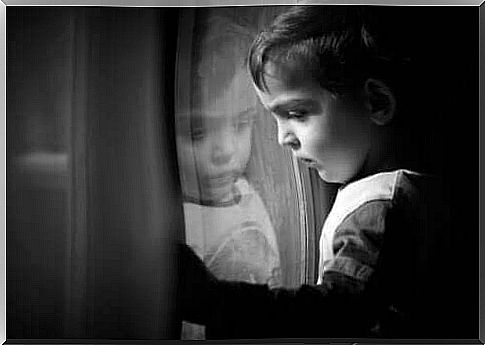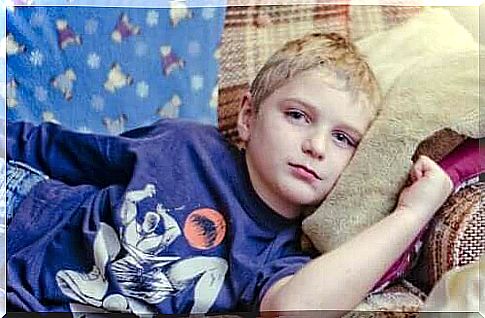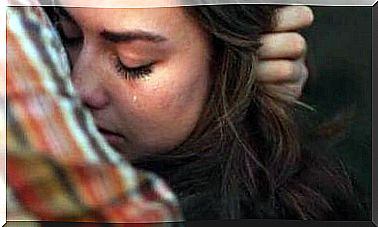Internalizing Disorders: Understanding Childhood Disorders

Children can sometimes show behaviors that are not related to their character. For example, extreme embarrassment, worry, fear, phobias and mood swings. In this sense, understanding, knowing and discovering the first indicators of internalizing disorders can help treat and prevent depression in children.
When it comes to children’s behavior, there is one fact that almost never fails. The most restless and rebellious children are the ones who always attract attention. Whether at home or at school, it is quite impossible not to notice the boy or girl who is defiant and who rarely ever sits still.
Now this type of profile falls within what we define as externalizing disorders. Basically, they react to their environment by making themselves noticeable. On the contrary, there are children who are far from problematic. These people do not like when other people notice them. There are those who like to sit in the back of the classroom and keep to themselves all the time. They avoid attention anyway.
Furthermore, teachers rarely ever notice them. In a way, the teachers enjoy these calm personalities of the children, especially in a classroom full of noisy, inattentive children. Nevertheless, neglect of these children or teenagers can have very serious consequences. Although they hide behind their elusive and calm appearance, in reality they cry for help.
Internalizing disorders: definition, symptoms and treatment
“Yes, he is always beside me, he never leaves my side.” “He is shy – he is one of those children who is afraid of everything.” “She has to go to the doctor all the time, when there is no stomach pain, there is a skin rash.”
This type of comment is common in parents of children with internalizing disorders. In general, it is not easy to see that what lies behind this behavior is actually a mental problem. This problem occurs on the surface, especially when a child who was not cared for in childhood reaches adolescence.
We all know how difficult adolescence can be. This phase is full of changes, making individuals vulnerable. Mentioned vulnerability causes this disorder to manifest. This is when self-harm and even suicidal thoughts can appear. A piece of research conducted at the University of Pennsylvania, Philadelphia, highlighted the relevance of developing early programs for the treatment and prevention of internalizing disorders.
Furthermore, the authors of this study noted that children with undiagnosed mental disorders are more likely to suffer from academic problems and social exclusion. However, the most serious problem is the risk of suicide. According to WHO data, suicide is a third most common cause of death among people between the ages of 15 and 19.
What are internalizing disorders?
According to Achenbach, Edelbrock and Howell (1987), the mental disorders that affect children can be divided into two typologies. First, we have externalizing behaviors (aggression, behavioral problems, disobedience, and inattention, among others). Second, it is internalizing behavior, which refers to manifestations related to somatization due to anxiety, stress, or depression.

Internalization disorders are very common in childhood and manifest as follows:
Emotional symptoms
- Excessive fear (darkness, animals, new situations)
- Weakness, sadness and an apathetic attitude
- Feelings of inferiority
- Concentration problems
- Negativity or always feeling that something bad is going to happen
Internal Disorders: Behavioral Symptoms
- Excessive attachment and dependence on adults
- Lack of motivation
- Nothing attracts the interest of the child or youth. They go from one hobby to another
- Secluded behavior
- The tendency to sit or lie down all day
- Professional problems and poor performance
Somatic manifestations
- Abdominal pain for no apparent reason
- Constant headache and dizziness without a clear trigger
- The occurrence of allergies, especially on the skin
Where do internalizing disorders come from?
What lies behind this internalizing symptomatology are anxiety disorders and depression. These realities tend to go unnoticed in childhood and adolescence for two reasons. First, adults tend to attribute to them the age of the individual. Think about it. It is quite common to think of pre-teens as more passive and introverted, while one usually thinks of teens as rebellious and careless.
On the other hand , it is important to keep in mind the family aspect. Many of the children with this type of disorder come from difficult backgrounds. In short, parents did not have their fixed parenting strategies and ended up neglecting their emotional needs. As a consequence, they were not able to realize that the children were having a hard time, which means that the school environment is the only scenario that is able to intuit the reality these children are going through.
Therefore, the triggers for these mental states are often quite complex. Yes, triggers can be neglect, abuse and mistreatment. However, there are also stressors (school changes, parental divorce), and it is of course important to be aware of personality variables and even genetic factors.

Internalizing Disorders: Therapeutic Approach
Systemic therapy is the common approach when treating internalizing disorders in children. Mental health professionals must not only focus on the child’s emotions, but also on the family environment. Likewise, the therapist must offer the child or young person different strategies that help them understand their own emotions and, for example, learn the body’s reactions to anxiety.
Improving social skills and self-confidence will allow them to have better self-esteem and in turn function with greater security and peace of mind. In addition, they will feel more in tune with everything and everyone around them. Early detection of the symptoms of these clinical realities should undoubtedly be a priority in our society.









